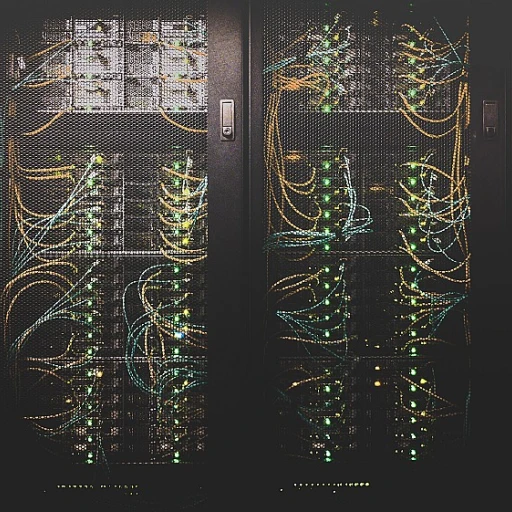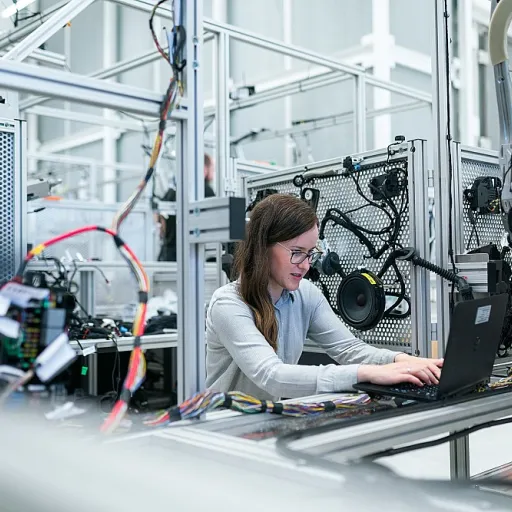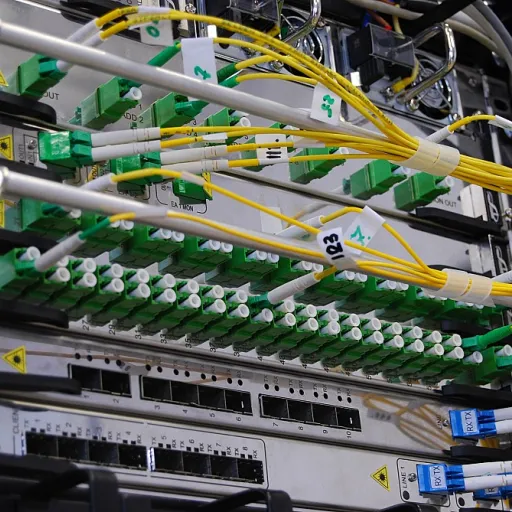
Emerging Technologies Shaping the Future
Emerging Technologies: The Road Ahead
The landscape of software is undergoing a seismic shift, driven by a confluence of emerging technologies that promise to redefine how we build and interact with digital solutions. As we look towards 2025, the view is clear: innovation is not just on the horizon; it's already powering the wheels of change.
One of the most significant trends is the integration of artificial intelligence (AI) into software development. AI's role is not just limited to automation but extends to enhancing the creative process, offering developers new tools to build more intuitive and responsive applications. This evolution is akin to upgrading from base models to high-performance vehicles, where AI acts as the turbocharged engine driving efficiency and innovation.
Moreover, the rise of quantum computing is set to revolutionize the specs of software capabilities. Quantum's power lies in its ability to process information at unprecedented speeds, offering a glimpse into a future where complex problems are solved in seconds rather than years. This technological leap is akin to shifting from traditional road vehicles to futuristic, multi-terrain machines that can navigate any challenge.
In parallel, the focus on sustainability is reshaping the software development process. The industry is moving towards eco-friendly practices, much like the automotive sector's shift to hybrid and electric vehicles. This transition is crucial as it aligns with global efforts to reduce carbon footprints and promote environmental responsibility.
As we navigate these changes, the human element remains pivotal. The evolution of skills and workforce dynamics will be crucial in harnessing these technologies effectively. Just as drivers need to adapt to new vehicle controls and features, software professionals must evolve to meet the demands of this new era.
For those interested in a deeper dive into these transformative technologies, exploring the potential of syntellis in software evolution offers valuable insights into how these changes are shaping the future of software.
The Role of Artificial Intelligence in Software Development
Artificial Intelligence: The New Power in Software Development
Artificial Intelligence (AI) is increasingly becoming the driving force behind the evolution of software. As we look towards 2025, AI is set to transform how software is built, tested, and deployed. The integration of AI into software development processes is not just a trend but a necessity, as it enhances efficiency and innovation.
AI's ability to process vast amounts of data and learn from it allows developers to create more intuitive and responsive applications. This capability is akin to having a powerful engine under the hood, providing the necessary power to tackle complex challenges. AI-driven tools can automate mundane tasks, allowing developers to focus on more creative aspects of software design.
Sequoia's Vision: Building with AI
Sequoia's view on the future of software emphasizes the importance of AI in shaping the next generation of applications. By leveraging AI, developers can build software that adapts to user needs in real-time, offering a personalized experience. This approach not only improves user satisfaction but also enhances the software's overall performance.
Moreover, AI contributes to the development of more robust cybersecurity measures, as discussed in the subsequent sections. By predicting potential threats and vulnerabilities, AI helps in creating a safer digital environment.
AI's Role in Enhancing Software Features
The integration of AI into software development also brings about significant improvements in features and functionalities. For instance, AI can enhance audio multimedia capabilities, providing users with a richer experience. Additionally, AI-driven multi-terrain control systems can optimize software performance across different platforms and environments.
As AI continues to evolve, its impact on software development will only grow. The ability to harness AI effectively will be a key differentiator for companies looking to stay ahead in the competitive software market. For more insights on how AI is shaping the future of software, you can explore the potential of Syntellis in software evolution.
Cybersecurity Challenges and Innovations
Innovative Approaches to Cybersecurity
As we delve into the future of software, cybersecurity remains a paramount concern. With the rapid evolution of technology, the threats to digital security have become more sophisticated. Sequoia's view on the future emphasizes the need for robust cybersecurity measures that can adapt to these emerging threats. The power of artificial intelligence, as discussed earlier, plays a crucial role in building advanced security systems capable of predicting and mitigating potential breaches.
One of the key challenges is the integration of cybersecurity within the software development lifecycle. Companies are now focusing on embedding security features right from the design phase, ensuring that the base specs of any software include strong protection mechanisms. This approach not only enhances the security posture but also reduces the overall cost of addressing vulnerabilities post-deployment.
Quantum Computing: A Double-Edged Sword
The advent of quantum computing presents both opportunities and challenges for cybersecurity. On one hand, quantum computing can significantly enhance encryption methods, providing a higher level of security. On the other hand, it poses a threat to current encryption standards, potentially rendering them obsolete. As Sequoia highlights, the industry must prepare for this shift by investing in quantum-resistant algorithms and exploring new ways to secure data.
Human-Centric Security Solutions
While technology plays a critical role, the human element cannot be overlooked. The evolution of the workforce, as mentioned in the discussion on skills, is vital for effective cybersecurity. Training programs that focus on developing skills in threat detection and response are essential. Additionally, fostering a culture of security awareness among employees can significantly reduce the risk of human error, which remains a leading cause of security breaches.
For more insights into how these elements come together in the realm of software development, you can explore the evolution of substance abuse EMR software.
The Impact of Quantum Computing on Software
The Quantum Leap in Software Development
As we look towards the future, quantum computing stands out as a transformative force in the realm of software development. Its potential to revolutionize the way we process information is akin to moving from a dirt road to a multi-lane highway. Quantum computing's power lies in its ability to handle complex calculations at unprecedented speeds, which could dramatically enhance the capabilities of software applications.
Quantum computing is not just about speed; it's about solving problems that are currently unsolvable with classical computers. This could lead to breakthroughs in various fields, from cryptography to material science. The implications for software development are vast, as developers will need to build new algorithms and frameworks to harness this power effectively.
However, the integration of quantum computing into software development is not without challenges. The current specs of quantum computers are still in their infancy, and the technology requires significant advancements before it becomes a staple in the industry. Companies like Sequoia are investing in research to view and build the necessary infrastructure that will support quantum computing's integration into software development.
Moreover, the introduction of quantum computing will necessitate a shift in the skills required from the workforce. Developers will need to understand quantum mechanics and its application in software, which will likely lead to a demand for specialized training programs. This evolution in skills is part of the broader trend of workforce evolution discussed in other sections of this article.
In conclusion, while quantum computing presents exciting opportunities, it also poses significant challenges that the software industry must address. The journey towards fully integrating quantum computing into software development is just beginning, and it will be fascinating to see how this technology reshapes the landscape in the coming years.
Sustainability in Software Development
Green Coding: A New Frontier
As the world becomes increasingly aware of environmental issues, sustainability in software development is gaining traction. The push for greener technology is not just about reducing carbon footprints but also about creating efficient, long-lasting solutions. This shift is evident in the way companies like Sequoia are reimagining their software strategies to align with eco-friendly practices.
Efficient Resource Management
One of the key aspects of sustainable software is efficient resource management. This involves optimizing code to reduce energy consumption and leveraging cloud computing to minimize physical hardware usage. By doing so, companies can significantly cut down on the power required to run their applications, leading to lower energy costs and reduced environmental impact.
Designing for Longevity
Another critical component is designing software with longevity in mind. This means creating applications that are not only robust and reliable but also adaptable to future technological advancements. By ensuring that software can evolve without needing complete overhauls, developers can reduce waste and extend the lifecycle of their products.
Collaborative Efforts for a Sustainable Future
Collaboration is essential in driving sustainability in software development. Companies, developers, and stakeholders must work together to establish standards and practices that promote eco-friendly development. This includes adopting open-source solutions, sharing best practices, and investing in research to explore new sustainable technologies.
As we look to the future, the integration of sustainability into software development will become increasingly important. By embracing these practices, the industry can not only contribute to a healthier planet but also build a more resilient and adaptable technological landscape.
The Human Element: Skills and Workforce Evolution
Adapting Skills for a New Era
As we look towards the future of software, it's clear that the human element remains crucial. The rapid advancements in technology, like those discussed in the context of artificial intelligence and quantum computing, demand a workforce that is not only technically proficient but also adaptable and forward-thinking.
Software professionals must continuously evolve their skill sets to keep pace with emerging technologies. This includes gaining expertise in AI-driven development tools and understanding the implications of quantum computing on software architecture. The ability to integrate cybersecurity measures seamlessly into development processes is also becoming increasingly important, as highlighted in the discussion on cybersecurity challenges.
Building a Diverse and Inclusive Workforce
Creating a diverse and inclusive workforce is essential for fostering innovation. Different perspectives can lead to more creative solutions and a better understanding of user needs. Companies like Sequoia are recognizing the power of diversity in building resilient teams that can tackle complex challenges.
Moreover, as software development becomes more intertwined with other industries, there is a growing need for interdisciplinary skills. Professionals who can bridge the gap between software engineering and fields like automotive technology, where terms like traction control, towing capacity, and multi-terrain features are relevant, will be in high demand.
Emphasizing Continuous Learning
The future of software development will be characterized by continuous learning and adaptation. Organizations must invest in training programs that keep their teams updated with the latest technologies and methodologies. This includes understanding the nuances of new tools and platforms, such as those used in the development of audio multimedia systems or load leveling suspension technologies.
Furthermore, as the industry moves towards more sustainable practices, professionals will need to understand how to build software that supports environmental goals. This involves not only technical skills but also a mindset geared towards sustainability.
In conclusion, while technology continues to evolve, the human element remains at the core of software development. By fostering a culture of continuous learning and diversity, the industry can ensure it is well-equipped to meet the challenges and opportunities of the future.





-large-teaser.webp)









